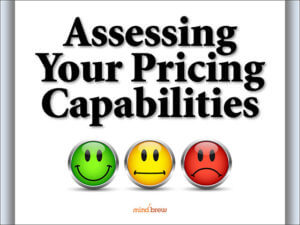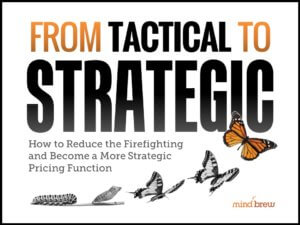When I was a consultant, one of the first things I always tried to do at the beginning of a new client engagement was a strategic assessment. The point wasn’t to gauge whether the client’s current processes were as efficient or as well-executed as they could be. No, the point of this strategic assessment was to figure out whether or not the client was doing the right things in the first place.
My rationale was very simple. In my experience, doing the right things…even in a suboptimal way…almost always outperforms doing the wrong things perfectly. It’s like that old football coach said:
“Do the right things and the score takes care of itself.”
In B2B pricing, the pressure for “consistent execution” and “maximum efficiency” has unfortunately led a lot of teams to focus heavily on tactical improvements. They strive for ever-cleaner data and ever-faster price changes and reports. They obsess over exception handling and quote turnaround times. They automate every process they can and develop procedures for every possible situation or scenario.
But if you’re tracking the wrong things, streamlining the wrong workflows, or automating the wrong processes, all of these tactical improvements only help you make the wrong moves even faster. And while all of the tactical effort might look productive, it rarely shows up in the results.
When the financial gains aren’t manifesting as planned or hoped, the immediate instinct is to double down and just “do it even better.” It’s a sort of tactical perfectionism. But the real leverage usually isn’t found in better execution of existing processes and procedures. Very often, the biggest gains will actually come from changing what we’re executing, rather than improving how well we’re executing it.
That’s why leading B2B pricing functions will periodically conduct strategic capability assessments. Not as some onerous exercise in self-flagellation, but as an ongoing, strategic gut-check.
These assessments are designed to reveal whether your current mix of people, processes, and practices are actually aligned with what the business is trying to accomplish. They help you distinguish between the operational noise and the true performance drivers.
And most importantly, these assessments force you to confront the possibility that the things your team is currently doing “really well” might not be the things that can make the most difference or have the biggest impact on results.
Conducting a useful strategic assessment doesn’t require an army of consultants. It just requires a bit of structure and enough humility to be reasonably objective. While we can help provide some structure through our downloadable B2B Pricing Capability Self-Assessment, you’ll need to provide the humility and objectivity.
It’s also useful to approach this kind of work with a consultant’s mindset, rather than a practitioner’s mindset. In other words, don’t assess your operation with an eye toward what’s already working or what’s currently sucking up your time and attention. Instead, assess your operation from an arms’ length to uncover the strategic “green field” opportunities you might be missing altogether.
Once you identify the strategic capability gaps, the next step is to prioritize. You can’t fix everything at once, so start with the areas that can produce measurable impacts in the near-term. These could be things like:
- Working with Marketing to get more compelling and differentiated value messaging into the marketplace.
- Refining price segmentation models to better reflect differences in price sensitivity and willingness-to-pay.
- Sourcing, securing, and providing ongoing negotiation training to improve realized prices and margins.
- Using comparative analysis to identify and correct over-discounting at an account, segment, and/or channel level.
Again, thinking like a consultant, you’ll want to pick a few high-value improvements, scope them to fit your available resources, and then work to drive small, demonstrable wins in fairly short order. These early wins then create the credible evidence and proof-points that will help you sell others on going even further and tackling even more strategic improvements.
In fact, when other stakeholders and decision-makers see that your strategic pursuits are generating tangible financial gains, the demand for even more of the “right things” will tend to grow on its own.
The bottom line is that doing things right really only matters when you’re doing the right things. And while it might sound a bit clichéd or even corny, when you consistently focus on the right things, the score really does take care of itself.















